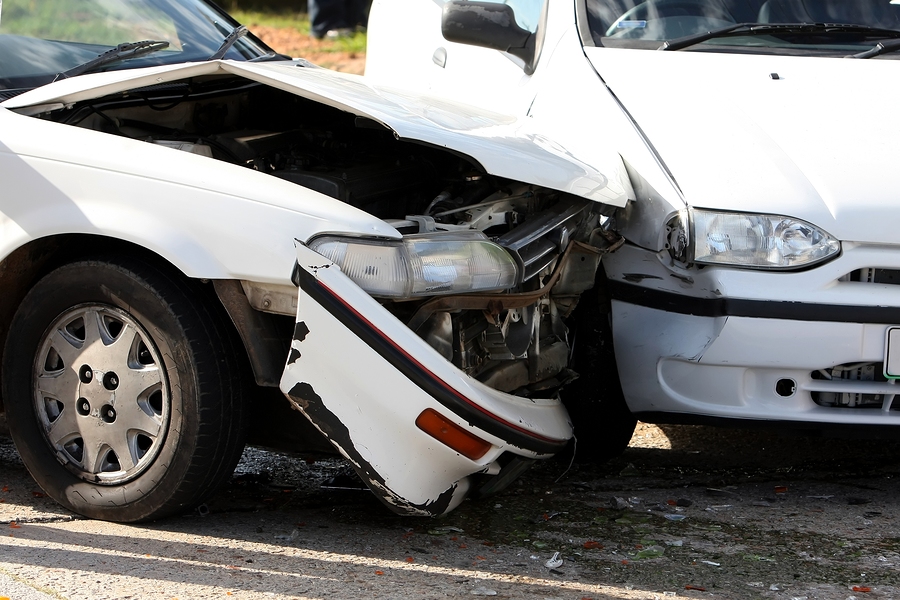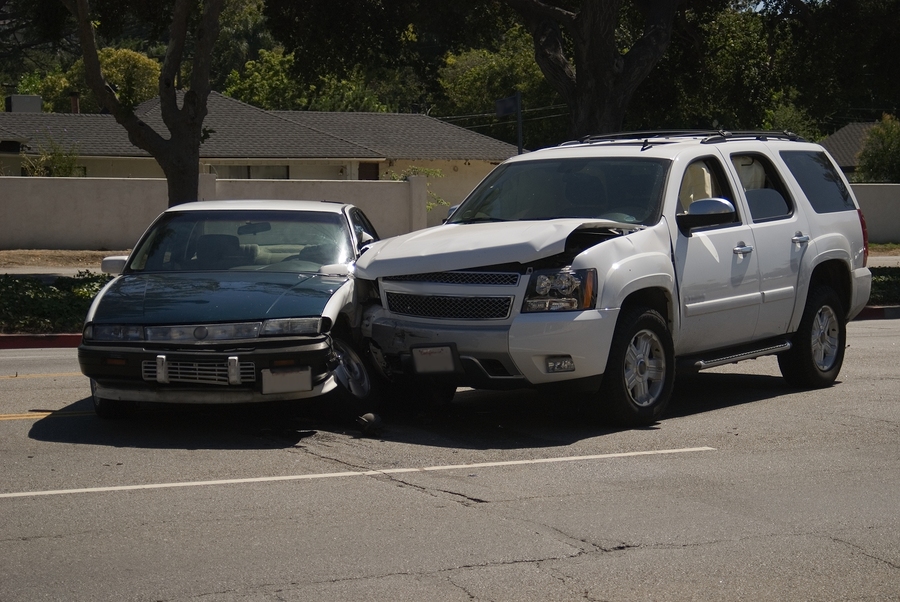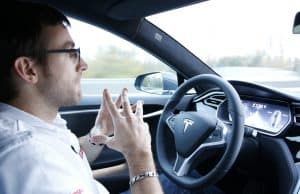T-bone accidents, also known as side-impact collisions, are not only hazardous but also can result in severe and devastating injuries. Furthermore, these accidents are not as straightforward as some individuals tend to assume. T-bone accidents occur from a variety of traffic situations, and depending on the circumstances, either driver may have caused the accident. To truly understand who is at fault for this type of collision, individuals need to understand the facts about T-bone accidents. At Gomez Trial Attorneys, our car accident lawyers want to help you understand who is at fault for your T-bone accident and what you need to do to maximize your compensation.

What Exactly Is a T-Bone Accident?
T-bone accidents usually occur when the front of one motor vehicle crashes into the side of another vehicle, making a “T” formation. Frequently, this collision happens at intersections when one of the drivers does not stop at a traffic light or stop sign and fails to give the other driver the right-of-way. What makes these accidents so dangerous is the limited amount of protection between the vehicles when the collision occurs. Consequently, the driver or the passenger will usually suffer extensive injuries, including grave brain injuries, spinal fractures, and broken bones.
What Evidence Do You Need to Prove Fault for a T-Bone Accident?
As is the truth in any car accident, T-bone accidents are not always black-and-white, as either driver may have caused the crash. In some instances, two or more drivers may have contributed. If you have been in a T-bone accident, and the other driver denies liability, immediately take the following actions:
Seek Medical Attention
Before you start digging for evidence, you need to seek medical attention. Even if your injuries do not require immediate assistance, make sure to see your doctor as soon as you can and get adequately examined. Your medical professional will verify that you do not have any significant head injuries or internal bleeding that needs medical intervention. Besides, getting your injuries on record after your accident can help prevent the insurance company or the at-fault driver from trying to show that your injuries were not a result of the accident but rather from a different superseding event.
Examine the Scene
After you call 911 and verify that it is safe to examine the scene, make sure to collect the following evidence:
- Pictures and video: Take as many pictures or videos of the accident scene as you can. Capture the damage to the vehicles and the position of the cars after the crash. Include photos of the area, such as any traffic signals or road signs, as well as any debris or hazards on the road. Finally, document the weather at the time of the accident, as well as any other characteristics that may help your claim, such as the other driver’s demeanor.
- Police reports: The police report will provide you with valuable information that you can use to your benefit. When local enforcement officers show up at the accident scene, they will take down statements from everyone involved in the accident, including any witness accounts. The officers may even provide their personal opinions of who caused the accident in their accident report, which may help your case down the road. However, just remember that not every police officer gets it right, and you should still retain a car wreck attorney that can conduct a thorough investigation into the accident to help you find additional evidence to support your case.
- Witness accounts: The best way to show that the other driver was at fault is through first-hand accounts of what happened. Whether it was pedestrians or other drivers on the road that witnessed the accident, getting their information may prove extremely beneficial when it comes to proving your claim. Especially when the insurance company or the other driver is trying to blame it on you.
- Do not admit fault: The number one thing you need to remember after a T-bone accident is not to admit fault. The statements you make after the crash may come back and hurt your claim, specifically if you make any affirmative statements that the other side can use to place the blame on you. The best thing you can do is just relay the facts and call an experienced attorney that can help protect your rights.
Common Type of T-Bone Accidents
Even though each accident is unique and the facts and circumstances are not the same for every T-bone accident, below we discuss some of the most common T-bone accidents.
Right-of-Way Accidents
Rules of the road apply to every driver. Specifically, these rules include the requirement that drivers obey traffic signals and signs and follow specific intersection rules. Failing to abide by these regulations can not only cause a deadly accident, but also it can show that a motorist is at fault for the collision.
However, just because a driver is following the general rules of the road does not mean that a driver will get off scot-free if he or she is driving without due care. For example, in a situation where you have the right-of-way, but you are not paying attention to the road, carelessly drive through an intersection, and an accident results. In this case, you may still have some accountability for causing the accident.
Left Turn Accidents
Some T-bone accidents result from one motor vehicle making a left turn in front of another vehicle. Before turning left, a left-turn driver must yield the right-of-way to all oncoming traffic that is close enough that it may pose a danger. Thus, unless it is safe enough to complete the turn, or the left-turn driver is proceeding on a left-turn green arrow, left-turn drivers must take precautions and wait to proceed. Due to these specific regulations, in most cases, the left-turning driver is usually to blame for the crash that occurs.
To prove otherwise is more complicated and requires extensive evidence and investigation to show that the other driver was somehow at fault because of his or her excessive speeding, failure to stop at a traffic sign, or driving while distracted. Regardless of the situation, speaking with an experienced auto accident lawyer can help you figure out the specifics of the accident and help determine who actually caused your injuries.
Running a Red Light or a Stop Sign
One of the more regular, but still dangerous, types of T-bone accidents involves a motorist running a red light or a stop sign. These collisions usually result when a driver is trying to beat a light while driving at high speeds and collides with a crossing vehicle. In other situations, a driver might think no one is coming and run a light, but then realize that he or she failed to look both ways before proceeding into the intersection. In these instances, the driver that fails to obey the traffic signal is usually at fault for the damages and injuries that the other driver sustained.
Bad Driving
Yes, not everyone is a perfect driver. In fact, most drivers would admit that they’ve made at least a few poor decisions while driving. In certain circumstances, faulty road conditions, unclear traffic signs, or even defective vehicle parts may cause an accident.
Regardless, bad driving can result in devastating T-bone accidents and usually includes the following behaviors:
- Excessive speeding
- Driving under the influence of drugs
- Driving under the influence of alcohol
- Driving while distracted
- Driving while texting
- Not staying alert at dangerous intersections
Why Proving Who Was At Fault for the T-Bone Accident Matters
Many states, including California, recognize a comparative negligence system, which means that if a plaintiff contributed to the accidents, he or she can still seek compensation. In addition, to bring a claim for damages, the injured party must establish a link between his or her injuries and the actions of the at-fault driver.
The big reason you need a car accident lawyer is to prove fault. If you cannot prove fault, then you may end up on the hook for the significant damages and costs that result from the accident, including:
- Medical bills: T-bone accidents can result in devastating injuries, often involving the head and the spine and sometimes leading to traumatic brain injury (TBI) and other life-altering diagnoses. The care required for these injuries is frequently expensive and may last for the victim’s entire life.
- Lost income and employment: Even if the injury was not catastrophic, victims usually have to take time off work to heal. In other situations, an injury may prove so severe that the victim cannot return to work, period. Whatever the circumstances, the injured party cannot work and, as a result, can’t support his or her family or loved ones.
- Rehab and specialized services: Many victims of these types of car accidents have to endure months or even years of rehab and specialized doctor visits. These medical services add up and can become quite expensive, especially when you factor in the travel expenses that come with these visits.
- Medical equipment and services: Sometimes, these traumatic injuries result in permanent paralysis, irreversible brain damage, and the inability to walk again. When this happens, victims need expensive medical equipment and services to live, such as wheelchairs and in-home care 24/7.
- Funeral services: Unfortunately, not everyone survives T-bone accidents. Depending on the specifics of the accident, many victims will perish instantly or as a result of their injuries, and sadly, the family will have to deal with not only heartbreak but also the burial and funeral expenses that result.
How Proving Negligence Helps Show Fault
Sometimes, the best way to show that a driver was at fault for a T-bone accident is to hire a knowledgeable personal injury attorney who understands the law and can build a strong legal case. Under the law, a driver whose negligence caused a car accident is liable for the damages and injuries that result.
To show that the other driver’s negligence caused the accident, the injured party needs to prove all of the following elements of negligence:
- The driver owed the injured party a duty of care.
- The driver breached that duty by acting negligently.
- The injured party suffered injuries.
- The driver’s negligence caused the injured party’s injuries.
Whenever you are driving a motor vehicle, you owe others on the road a duty of care to drive safely. Accordingly, you must:
- Make sure to control the movement and speed of the motor vehicle.
- Make sure to use reasonable care when operating a motor vehicle.
- Make sure to look out for other vehicles, obstacles, and pedestrians.
Proving negligence requires ample evidence to make sure that you can successfully establish all of the required elements. When you retain an experienced attorney, he or she will research, investigate, and find the evidence needed to prove your claim.
How a Car Accident Attorney Can Provide Assistance in the Aftermath of a T-Bone Accident
T-bone accidents are diverse, complicated, and challenging. If you’ve recently been involved in a T-bone accident, you’re likely dealing with significant injuries and expenses. If the other driver is not admitting fault, the whole situation can make your life feel incredibly stressful. In these types of crashes, consult a knowledgeable car accident lawyer who has the experience to explore all of your options and build the most persuasive case on your behalf.
Car accident attorneys have the resources to recreate and investigate the scene of the crash by obtaining witness accounts, police reports, and even the motor vehicle’s black box. Your car accident lawyer will also take over all communications with the other driver’s attorney and the insurance company, making sure the opposition treats you fairly throughout the process. That is why if you or a family member were in a T-bone accident, it is vital to retain a car accident attorney who can fight for you while you finish healing and get back to your life.







